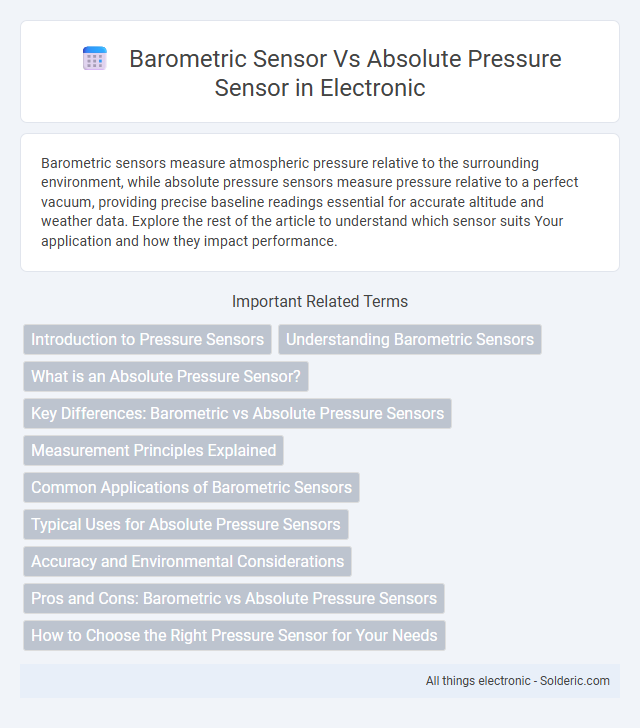Barometric sensors measure atmospheric pressure relative to the surrounding environment, while absolute pressure sensors measure pressure relative to a perfect vacuum, providing precise baseline readings essential for accurate altitude and weather data. Explore the rest of the article to understand which sensor suits Your application and how they impact performance.
Comparison Table
| Feature | Barometric Sensor | Absolute Pressure Sensor |
|---|---|---|
| Definition | Measures atmospheric pressure relative to sea level | Measures pressure relative to perfect vacuum (0 Pa) |
| Measurement Range | Typically 300 to 1100 hPa (hectopascals) | Wide range from 0 Pa to several atmospheres |
| Application | Weather forecasting, altitude detection, HVAC systems | Vacuum systems, fluid level measurements, industrial processes |
| Reference Point | Atmospheric pressure baseline | Zero pressure (vacuum) baseline |
| Output Type | Relative pressure with altitude corrections | Absolute pressure value without environmental reference |
| Accuracy | High accuracy at atmospheric conditions | High precision across wide pressure and vacuum ranges |
| Common Technologies | MEMS, piezoresistive, capacitive sensors | Piezoelectric, capacitive, strain gauge sensors |
Introduction to Pressure Sensors
Pressure sensors measure force applied by a fluid or gas, converting it into an electrical signal for monitoring or control. Barometric sensors specifically detect atmospheric pressure, critical for weather forecasting and altitude measurement in devices like smartphones. Absolute pressure sensors measure pressure relative to a perfect vacuum, providing precise readings essential for applications such as vacuum systems and industrial process control.
Understanding Barometric Sensors
Barometric sensors measure atmospheric pressure to determine altitude and weather changes by detecting air pressure variations. Absolute pressure sensors provide pressure readings relative to a perfect vacuum, making them suitable for applications that require precise pressure measurements regardless of environmental conditions. Understanding barometric sensors helps you accurately track altitude and forecast weather by leveraging their sensitivity to changing atmospheric pressure.
What is an Absolute Pressure Sensor?
An absolute pressure sensor measures the pressure relative to a perfect vacuum, providing precise readings essential for applications where accurate atmospheric pressure data is critical. Unlike barometric sensors, which typically measure atmospheric pressure at sea level, absolute pressure sensors can measure pressure in sealed environments or varying altitudes. Your system's accuracy in monitoring pressure changes improves significantly when using an absolute pressure sensor for tasks like weather forecasting, altitude measurement, or industrial process control.
Key Differences: Barometric vs Absolute Pressure Sensors
Barometric sensors specifically measure atmospheric pressure and are calibrated to account for altitude variations, making them essential for weather forecasting and altitude detection. Absolute pressure sensors measure pressure relative to a perfect vacuum, providing precise readings in sealed environments like industrial processes or fluid systems. The key difference lies in their reference points: barometric sensors use atmospheric pressure with altitude compensation, while absolute pressure sensors use a vacuum baseline for accurate pressure measurement.
Measurement Principles Explained
Barometric sensors measure atmospheric pressure by detecting changes in air pressure relative to the surrounding environment, typically using a sealed chamber with a flexible diaphragm. Absolute pressure sensors measure pressure relative to a perfect vacuum, providing precise readings unaffected by environmental pressure fluctuations. Your choice depends on whether you need relative atmospheric data or an exact pressure measurement in sealed or controlled environments.
Common Applications of Barometric Sensors
Barometric sensors are commonly used in weather stations, altimeters, and smartphones to measure atmospheric pressure and predict weather changes or determine altitude. These sensors provide precise pressure readings that enable applications such as GPS altitude correction and aviation instruments. Unlike absolute pressure sensors, which measure pressure relative to a vacuum for industrial processes, barometric sensors are optimized for ambient atmospheric conditions.
Typical Uses for Absolute Pressure Sensors
Absolute pressure sensors are commonly used in applications requiring precise measurement of pressure relative to a perfect vacuum, such as in altimeters, weather monitoring systems, and industrial process control. These sensors are crucial for monitoring pressure in sealed environments, ensuring accurate readings in vacuum chambers, and aiding in fluid level measurement in tanks. Your system benefits from absolute pressure sensors when accurate, stable pressure data unaffected by atmospheric changes is essential.
Accuracy and Environmental Considerations
Barometric sensors typically measure atmospheric pressure with high accuracy but can be influenced by local weather changes, requiring frequent calibration for precise readings. Absolute pressure sensors provide direct pressure measurements relative to a perfect vacuum, offering consistent accuracy unaffected by altitude or weather fluctuations. Environmental factors such as temperature, humidity, and altitude can impact the performance of barometric sensors more significantly than absolute pressure sensors, which are better suited for stable and harsh environments.
Pros and Cons: Barometric vs Absolute Pressure Sensors
Barometric sensors offer high sensitivity to atmospheric pressure changes, making them ideal for altitude measurement and weather monitoring, but they can be less accurate in sealed environments due to their reliance on ambient pressure. Absolute pressure sensors measure pressure relative to a perfect vacuum, providing consistent and reliable readings in sealed systems and harsh conditions, but they tend to be more expensive and complex. Choosing between barometric and absolute pressure sensors depends on the application requirements for accuracy, environmental exposure, and cost constraints.
How to Choose the Right Pressure Sensor for Your Needs
Selecting the right pressure sensor depends on the application's specific requirements for accuracy and environmental conditions; barometric sensors measure atmospheric pressure and are ideal for weather monitoring and altitude detection, while absolute pressure sensors measure pressure relative to a perfect vacuum, making them suitable for sealed system monitoring and process control. Consider factors such as pressure range, measurement accuracy, response time, and whether the sensor must compensate for altitude or external pressure variations. Understanding these parameters ensures choosing a sensor that delivers reliable, precise data tailored to your operational needs.
barometric sensor vs absolute pressure sensor Infographic

 solderic.com
solderic.com